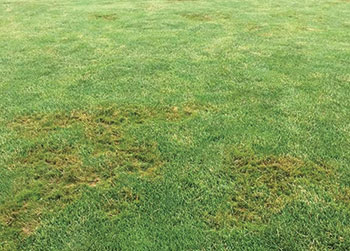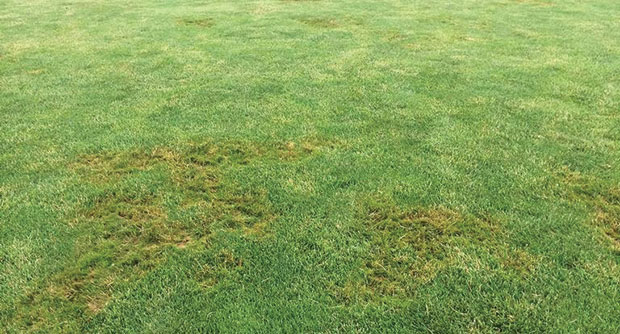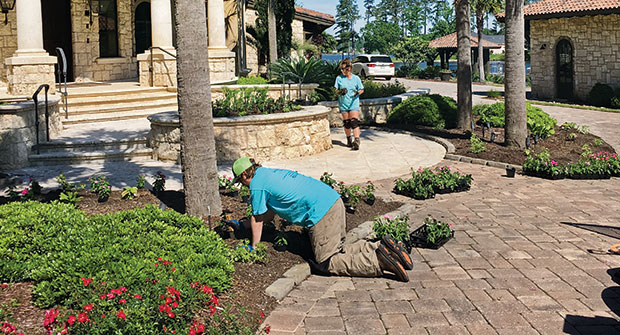
With Pythium blight, it’s often a case of mistaken identity, says Jim Kerns, Ph.D., associate professor of etiology, epidemiology and management of warm- and cool-season grass diseases at North Carolina State University.
“Most people think they have Pythium blight when, indeed, it’s gray leaf spot,” he says. “I hear a lot of people talking about (Pythium blight), and I’ve rarely diagnosed it myself.”
Because it’s so easy to misdiagnose, proper identification is critical when it comes to Pythium blight.
Telltale symptoms
Certain species of turfgrass can be more susceptible to Pythium blight than others, says Emma Lookabaugh, technical service representative for the Southeast for BASF. These include cool-season grasses such as perennial ryegrass and annual bluegrass. But, she says, most grass species, including Bermudagrass, can get Pythium blight. Kerns says tall fescue is also susceptible to the disease.
One telltale symptom of Pythium blight might include a small, dark spot on a lawn that becomes more irregular over time. The spots are sometimes black to purple and turn orange-brown over time, Kerns says.
“They’ll see blotches in their lawn, and that looks really similar to leaf spot diseases or other turf diseases,” Lookabaugh says. “Leaves will appear water soaked. They can sometimes look greasy.”
Favorable conditions
For cool-season grasses, turf is most susceptible as early as when daytime temperatures hit 65 degrees F. It becomes more of a problem as heat and humidity rise.
“The conditions that are most favorable are typically nighttime temps above 72 degrees F and high relative humidity above 85 percent,” Kerns says.
For warm-season grasses, Pythium blight strikes during cool, cloudy and wet weather when temperatures are above 50 degrees F but can occur year-round.
“Usually once you have Pythium, you may have it every year or see it pop up when conditions are favorable. The pathogen produces long-term survival spores,”Lookabaugh says. “It is a disease associated with high soil moisture and usually it’s more problematic in low-lying, poorly drained areas.”
Pythium spores can travel through surface water, and the disease can spread rapidly, she says.
“If conditions favor disease development, you can have a huge area in your yard that sustains significant damage in two to three days,” she says.
Get it right
Knowing how quickly Pythium could spread, getting the diagnosis right the first time is critical.
“A couple of years ago, during seedings, most people were treating for dampening off, which is similar to Pythium blight, but they weren’t seeing any effect,” Kerns says. “It was actually gray leaf spot that was killing those new seedlings.”
There are plenty of resources to help assess what disease is affecting the turf, such as local land-grant universities or turfgrass diagnosis labs.
Control methods
If disease pressure is low, experts say products with quinone outside inhibitors, such as azoxystrobin, fosetyl Al, pyraclostrobin or potassium phosphite, are good options. But, if disease pressure is high, experts suggest using Pythium specialists, such as products with cyazofamid, mefenoxam and propamocarb.
Kerns says mefenoxam can be applied as a liquid or granular fungicide, but he recommends using the liquid version.
“Repeat applications every 14 to 21 days as long as conditions favor disease development,” Lookabaugh says.
Other simple control solutions might be to water early in the morning so leaves have a chance to dry. Turn off irrigation systems if there is excessive wet weather.
“If you have excessive nitrogen rates, you’re essentially creating lush succulent leaves, and that are just perfect for Pythium,” Lookabaugh says.
Additionally, consider avoiding mowing if possible to eliminate the pathogen’s spread. If mowing is necessary, don’t put infected clippings back on infected areas.
“It’s a tricky pathogen. It’s hard to work with, but if you’re in a good preventive spray program, you can maybe get ahead of it,” Lookabaugh says.


